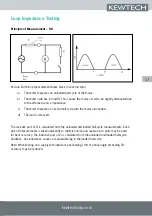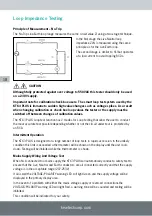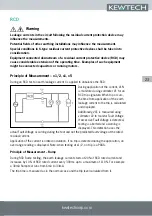
kewtechcorp.com
20
Whilst No-Trip testing at points on the final circuit will normally function with a high level of
accuracy, it should be noted that the low current measurement technique used is more likely to
be adversely affected by external factors such as noise on the mains supply.
Circumstances such as testing at seldom used socket outlets with tarnished contacts or testing
a circuit with a lot of background noise from electronic apparatus can result in the occasional
erroneous reading.
For this reason it is recommended that multiple measurements are made when using the No-trip
mode and any isolated odd results are ignored. When taking multiple readings the tester should
be disconnected from the supply between consecutive tests.
For safety reasons the No-Trip mode is recommended for all measurements made on TT
systems.
Where practical all other equipment powered by the same circuit should be switched off before
testing. This will reduce the chances of the RCD tripping as a result of combined leakages.
PFC / PSC
In both Loop test modes the KT63 PLUS will also display the supply voltage and at the touch
of the PFC PSC / Loop button the PFC / PSC depending on being connected L-E or L-N, will be
displayed.
Test Lead Configuration
The KT63 PLUS Loop test function can be used with 2 types of connecting lead. It is important to
understand and use the correct lead configuration for each test mode or you may not obtain the
correct results.
Lead Options
Kewtech KAMP12 mains lead with 3 x 4mm connectors to 13A plug
Kewtech ACCO63 3 wire distribution board test lead set that can be fitted with either prod tips or
crocodile clips as required.
2 Wire lead configuration Brown (live) Blue (neutral) Green (earth) are connected into the
instrument. The neutral is inserted into the back of the earth lead at the prod (or croc clip) end to
give a combined contact for 2 wire test method.
The brown test lead can be substituted by using the brown remote test probe supplied. This
allows remote activation of the KT63 PLUS from the safety of the test probe ensuring that you
are always looking at the point of contact and not the KT63 PLUS.



























